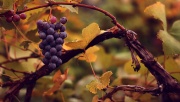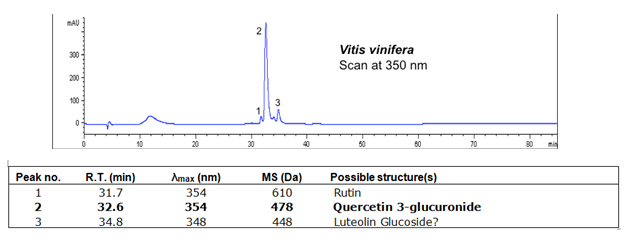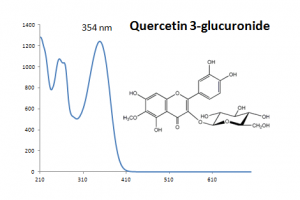Difference between revisions of "Grape leaves (Vitis vinifera) LC"
| (2 intermediate revisions by the same user not shown) | |||
| Line 1: | Line 1: | ||
| − | [[File:|thumb| | + | [[File:Vitis vinifera.jpg|thumb| cultivated Common Grape Vine, By eflon (Alex from Ithaca, NY) - Flickr, CC BY 2.0, https://commons.wikimedia.org/w/index.php?curid=16961598]] |
== Description == | == Description == | ||
| Line 49: | Line 49: | ||
| Quercetin 3-glucuronide | | Quercetin 3-glucuronide | ||
| 32.6 | | 32.6 | ||
| + | | 478 | ||
| 354 | | 354 | ||
| Major component | | Major component | ||
| − | |||
|- | |- | ||
| Luteolin glucoside? | | Luteolin glucoside? | ||
| 34.8 | | 34.8 | ||
| + | | 448 | ||
| 348 | | 348 | ||
| Possible | | Possible | ||
| Line 63: | Line 64: | ||
[1] Euro+Med Plantbase Project: Vitis vinifera. | [1] Euro+Med Plantbase Project: Vitis vinifera. | ||
| − | |||
| − | |||
| − | |||
| − | |||
Latest revision as of 08:51, 29 September 2017

Description
Vitis vinifera (common grape vine) is a species of Vitis, native to the Mediterranean region, central Europe, and southwestern Asia, from Morocco and Portugal north to southern Germany and east to northern Iran.[1] It is a liana growing to 35 yards (32 m) in length, with flaky bark. The fruit is a berry, known as a grape; in the wild species it is 6 mm (0.24 in) diameter and ripens dark purple to blackish with a pale wax bloom; in cultivated plants it is usually much larger, up to 3 cm (1.2 in) long, and can be green, red, or purple (black). The species typically occurs in humid forests and streamsides.
The leaves were used to dye yellow.
Historical importance
Summary of results
Flavonoid glycosides were identified, mainly quercetin 3-glucuronide as the major compound.
Analytical instrumentation and procedures
HPLC-DAD-MS analysis was performed with an Agilent 1100 liquid chromatography system consisting of an automatic injector, a gradient pump, a HP series 1100 DAD, and an Agilent series 1100 VL on-line atmospheric pressure ionization electrospray ionization mass spectrometer. Separations were done on a Vydac 214TP52 analytical column (2.1 mm diameterX250 mm; 5-ím particle size). The column was eluted at a flow rate of 0.2 mL/min with a tertiary gradient of water (A),acetonitrile (B), and 1% (v/v) aqueous formic acid (C) with the following elution program: 0 min, 90% A, 5% B, 5% C; 0-55 min, a linear gradient to 35% A, 60% B, 5% C; 55-60 min, a linear gradient elution to 15% A, 80% B, 5% C; 60-62 min, isocratic elution at 15% A, 80% B, 5% C; 62-70 min gradient elution to 90% A, 5% B, 5% C; and reequilibration with the latter solvent for 15 min. The mass spectrometer was run both in the positive and negative ion mode.
Chromatograms
Sample information
Identified compounds
| Compound | RT (min.) | MW | UV/vis | Other | |
|---|---|---|---|---|---|
| Rutin | 31.7 | 610 | 354 | minor peak | |
| Quercetin 3-glucuronide | 32.6 | 478 | 354 | Major component | |
| Luteolin glucoside? | 34.8 | 448 | 348 | Possible |
References
[1] Euro+Med Plantbase Project: Vitis vinifera.


